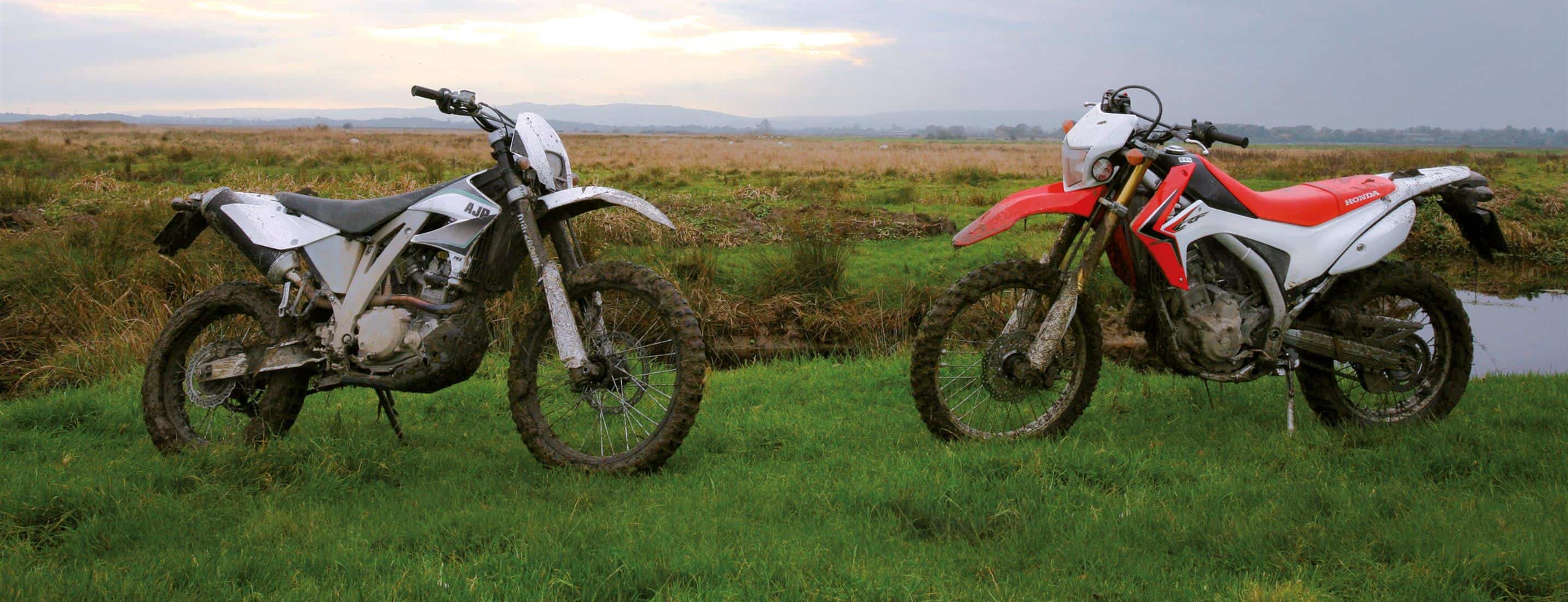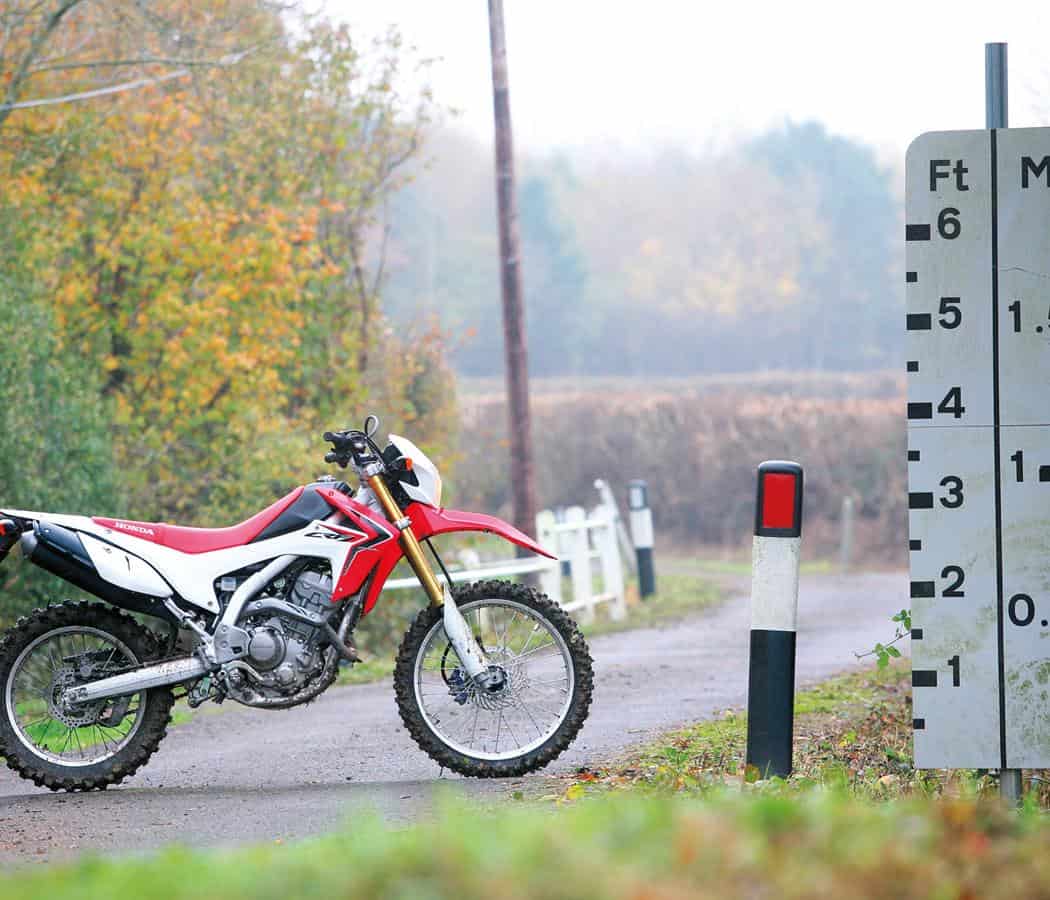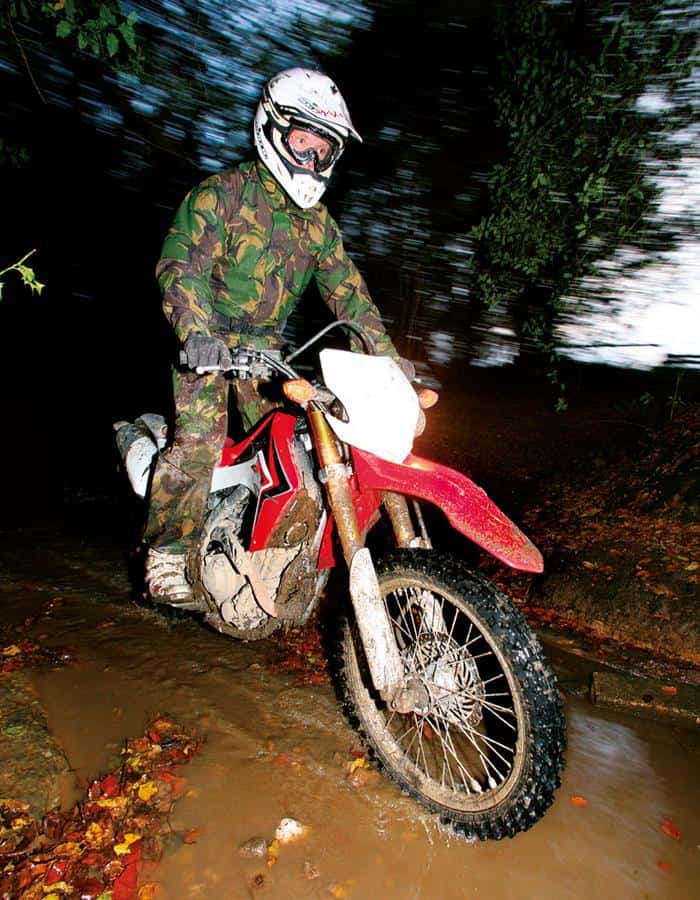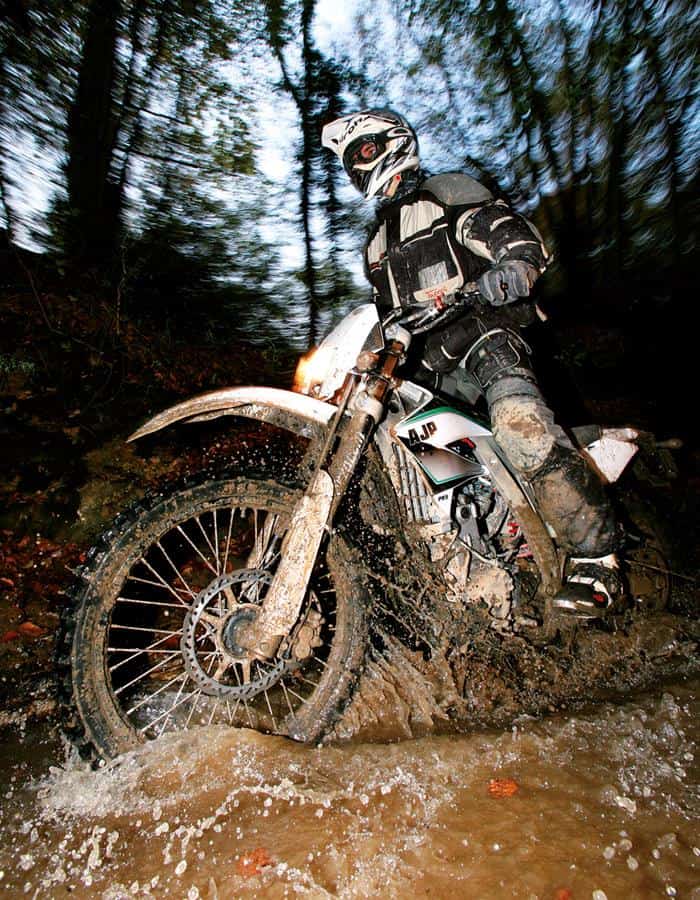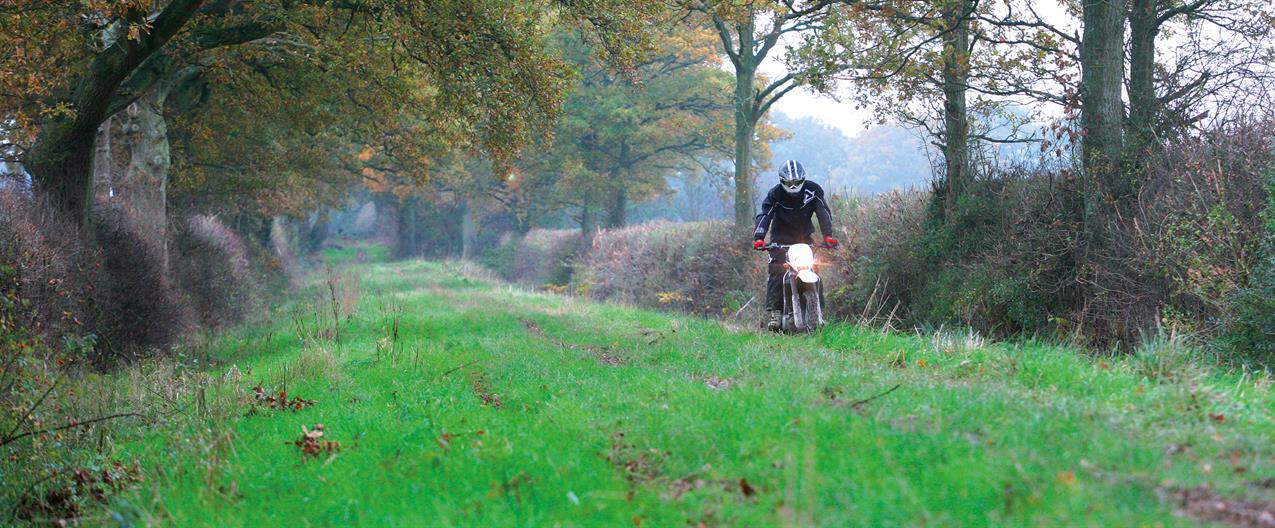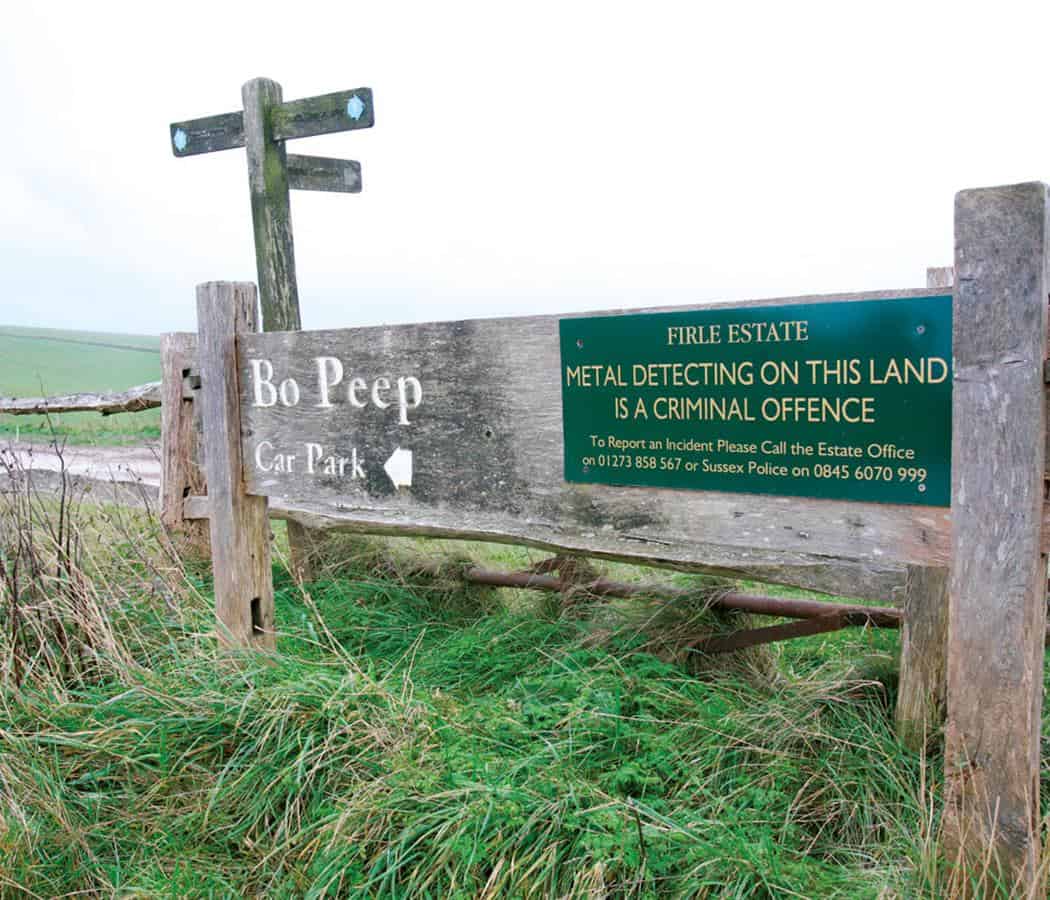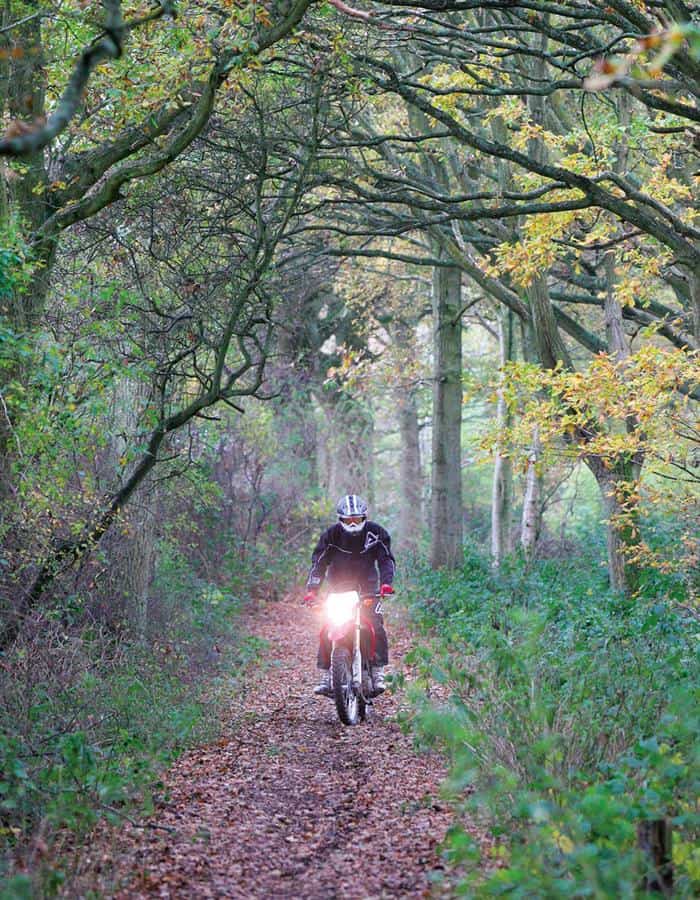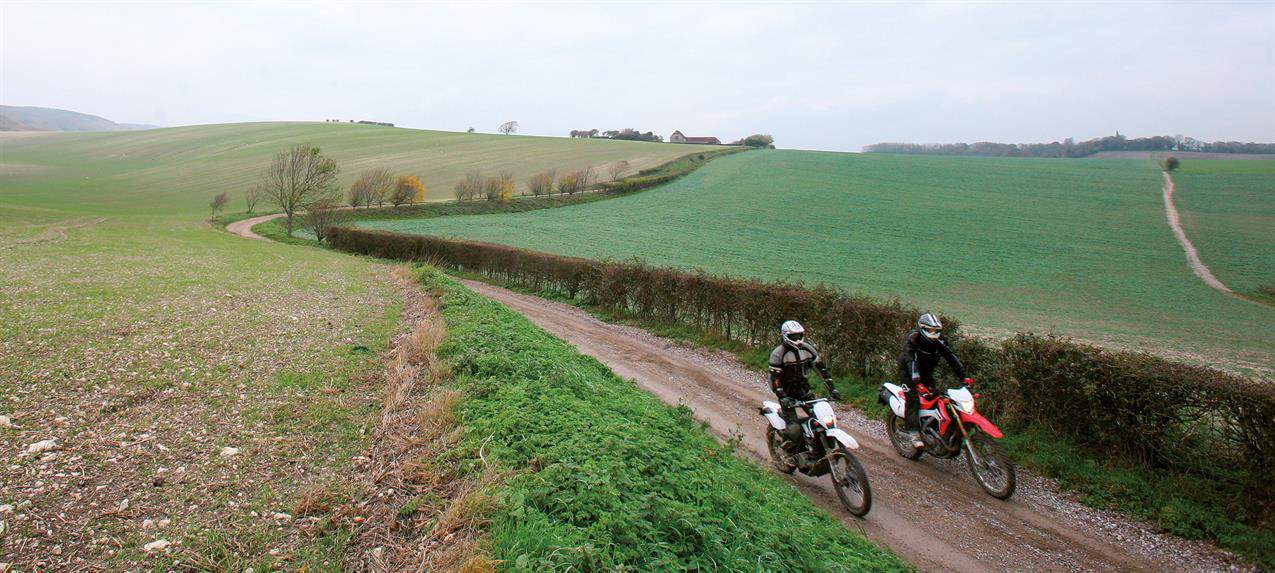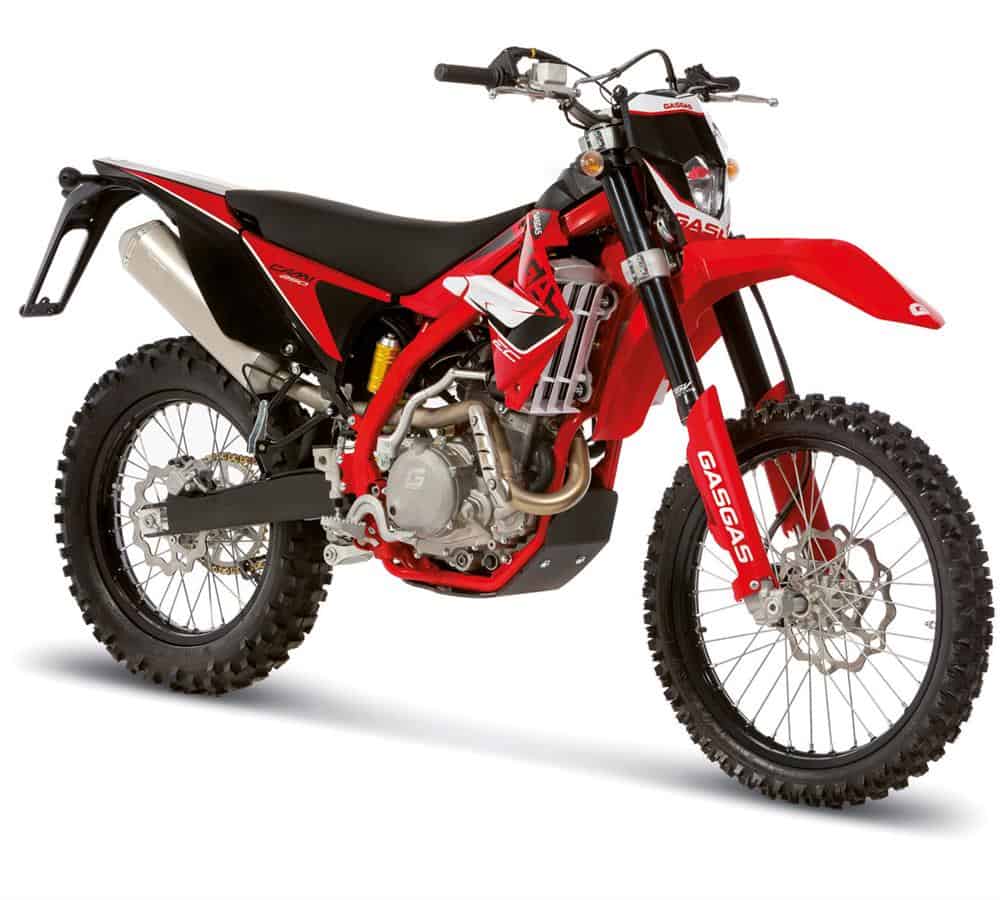With the choice of trail bikes once again on the rise, Rust took to the lanes with two of our old favourites…
The trail bike is back. For years we’ve seen manufacturers – especially the Big Four, who back in the ’80s and ’90s churned out robust little green laners – disregard this sector or concentrate on flogging us enduro bikes. Meanwhile, those of us who want to ride modern-day machinery have been scooting around on competition kit, that’s overly complicated and more expensive than a trail bike need be…
Now we’re seeing new trail bikes appearing from manufacturers big and small. Yamaha have their WR250R (not that you can buy one in this country, tho’); Kawasaki the KLX250; Beta build the Alp 4.0; Stefan Pierer has been making noises about KTM adding a sub-400cc, Indian-built, dual sporter to their range; and even TM, who have been staunchly ‘competition-only’ for as long as I can remember, displayed a trail version of their 250 four-stroke at the recent EICMA show in Milan (though it’s no cheaper than their enduro bike).
Perhaps the manufacturers have realised that examples of those old trailies we know and love – the Serow, CRM, DR and their ilk – are all getting on a bit now, and the market needs an injection of fresh metal to keep it ticking over. Or is it the fact that we’re now demanding more versatile machinery or simply cheaper ways to get dirty? Whatever the reason, it’s nice to once again have a choice of contemporary trail bikes…
The Odd Couple
Honda’s take on ‘what makes a trail bike’ is the same as it’s always been (though it employs some up-to-date technology): Make it comfortable, robust and versatile. And don’t worry too much about the weight. A combination of chunky steel parts, the EFI’d motor from the CBR250, a thickly padded seat and roadbike accoutrements means the 250L tips the scales somewhere north of 140 kilos. But when you’re pricing a bike under four grand (£3995 OTR at the time of going to press in 2013) you don’t waste your profit speccing weight-saving fancy-pants aluminium and the like…
Nor do you give it expensive adjustable suspension – the 43mm USD forks and Pro-Link rear-end are both no-frills basic. Instead you spend the money fitting decent modern clocks and switchgear, which from an off-road standpoint look vulnerable in a fall but are excellent for everyday use. This is a traditional ‘trail bike’ – as happy on the tarmac as it is on the lanes – and shares nothing other than a vague family resemblance with the rest of the CRF range.
AJP came at the same subject from a different angle. The Portuguese ‘Trail’ models are similar to their ‘Enduro’ bikes, only running lower specced chassis components (even so, the front suspension is adjustable), pillion pegs, and a more basic exhaust system. So you get the fuel injected, liquid-cooled 249cc motor, the steel/alloy composite frame, and the wonderfully slim dirtbikey ergos for £4200 (in 2013).
AJP aren’t overly concerned with building the most ultra-lightweight bikes available, and whilst the PR5 isn’t as portly as the Honda, its compact dimensions disguise some reasonable heft. We weren’t able to weigh this particular one, but I’d peg it somewhere around the high 120s. The kilos are mostly caught up within the frame and that oversize swingarm – they certainly haven’t scrimped on the metal. Parts such as the switchgear, clocks, headlight and seat are comparatively lightweight dirtbike items.
Road and Track
The lanes of East Sussex looked to be a fine place to split the two machines. A variety of trails – slippery chalk, flowing turnpikes, forest trails, and a smidgen of stony climbs plus a mix of roadwork, from twisty singletracks to dual carriageways – would make it as comprehensive as we could squeeze into a winter’s ride. John Vannuffel offered his services as a guide – being more than up to the task as one of Sussex TRF’s Rights of Way officers – backed up by friend, and trainer at local dirtbike dealers Freestyle Motorcycles, Steve Aylard.
A few miles of road first, and the Honda lapped it up. Once you’ve revved through the short first gear, the CRF whizzes along in the kind of smooth and unhurried manner that you simply don’t get on an enduro bike, and even some trailies. The front knobbly we’d fitted in place of the standard block pattern rubber sacrificed on-road feel and stability for grip in the mud, but that’s my only complaint. The splendidly low seat (875mm) means there’s potential for taller riders to feel cramped, though I suspect you’ll only notice this if you’re slogging along endless A-roads…
Bumping down the first trail, I’m pleasantly surprised by the way the 250L carries and controls its weight. Some trail bikes that are great on the road suddenly become lumbering wayward liabilities on the dirt, crashing into every bump and pushing the front-end thanks to awkward geometry. Not the Honda…
However, it’s the PR5 Trail that is ideally built for the lanes. The suspension is taller than that of the CRF, and initially feels firmer too. Start working those springs and the set-up is actually soft yet reasonably well-damped, so at trail speeds it gives a comfortable ride without tying itself in knots or crashing into the bumpstops.
Surprisingly, the AJP’s handling didn’t disappoint on the roads either, with great feel from the front-end and a level of stability that really impresses for a small bike. But it just can’t match that Honda engine for smoothness or comfort (or pace) and although the exhaust note itself is quiet (once we’d fitted the correct baffle in place), I personally found the induction noise very tiresome. Especially having just stepped off the barely audible Honda…
A few trails into the ride we arrive at a sign proclaiming the way ahead to be closed to vehicles. John points out that, if you read past the large typeface and into the small print, this only applies to four-wheelers. Result. The bright yellow signs become a regular feature of the day, and it’s clear that such seasonal exclusions are keeping the trails in good condition. The slippery ascent waiting for us past that first sign, certainly wouldn’t stand up to the passing of too many 4x4s but our low-impact trailies make steady work of it…
Given the incredibly smooth nature of the CRF’s power delivery, I’m expecting it to struggle for grip in the slick conditions, yet it puts its power down easily and efficiently always driving forwards smoothly. The AJP has more of a thudding delivery – not so much as an old air-cooled XT, more like a SOHC enduro lump – and this means that it too finds excellent traction. Even innocuous trails such as Nash Street – a wide and straight bimble that’s been transformed from a quagmire thanks to some serious engineering and a stream diversion – threaten to catch us out with slimy mud hiding under lush grass, yet both bikes progress along it effortlessly.
Passing through the quaint village of Wilmington, where the Long Man drawn in the chalk hillside looks down from on high, we head for the old coach road. Built in 1752, at the orders of Wellington so that he had an easy link between Dover and Portsmouth, this long sweeping trail (the longest in the county) presents a different test for the bikes. Up on the pegs for quite some time, the Honda’s comfort wanes slightly. The pegs, though not tiny, dig into the soles of my boots and the bars are just a touch too low for my tastes. The 875mm seat height also means that it takes greater effort to stand-up in the first place.
The more familiar dirtbike ergos of the AJP mean that it’s easier to ride stood up, and with a greater distance between seat and pegs not only is the transition from seated to standing easier, but you’re also less cramped when in the saddle.
We reach the westernmost end of the trail and then turn to run through it again. Rev through one gear, snick another with a purposeful boot (both bikes require a positive gear change), then repeat until cruising speed is attained. It doesn’t matter which bike you’re on, the power is linear right up into the top-end and there’s enough torque to be able to short-shift from the midrange without losing too much pace.
On a High
It’s a glorious time of year to be out on the trails, as the fiery hues of the oak and beech trees fill the scenery and counter the murky grey skies. Oh, for a glint of golden winter light. Mother Nature teases us with a few patches of blue sky as we climb Bo Peep Bostal onto the South Downs, but they soon fade to grey.
We’re really only nipping up the hill to look at the view (or what little of it we can see…) though the twisty tarmac ascent provides some fun. We’ve got the army to thank for the road, as during WWII they improved access onto the Downs so that they could use them as a training area.
I mention to John that it’d make a great (tarmac) hillclimb course – apparently the Bentley car club thought the same until one of the racers lost control and plunged off the edge into the chalk pit below.
Having stopped for fuel – the CRF supping 3.5L to the AJP’s 4.5L – we head for Pevensey Marshes – where the wide flat expanse of wetland nature reserve is in stark contrast to the rolling hills we’ve left behind. We take the northern-most of three trails that cross the site, the other two being closed for maintenance and improvements after Range Rover-swallowing bombholes developed, and the mud ‘schlicks’ and ‘schtooks’ as it grips and releases our slithering tyres.
Catching a peg on the edge of a 4×4 rut, I’m reminded that neither bike offers quite the ground clearance of a competition machine. Mind you, we’ve experienced far lower pegs on similar budget trailies so it’s not all bad. It does make you assess such obstacles well in advance tho’ – take a tumble here and it’d be easy to end up in the deep, dark pools and ditches running alongside the trail.
Kit Up
For many riders, a ‘trailie’ should be comfortable, refined and well-equipped. Something of a do-it-all machine. With these criteria in mind, it’s the Honda which has the edge. There’s no rack attached to the CRF-L, though it doesn’t look like it’d be hard to simply strap some luggage to the back-end – there are plenty of places to hook bungies and tie straps. The silencer is well-shrouded and sits below the level of the rear mudguard, so you’re unlikely to melt your tent on the pipe.
Attaching much more than a small tailpack to the AJP is likely to be more problematic. Its silencer juts proud of the fender, and the slimmer profile of the Portuguese plastics will make it harder to keep your kit in place. If you do mount something on the back-end – such as a large Kriega tailpack or Giant Loop luggage ‘yoke’ – you’ll want to ensure that you don’t cover the fuel filler cap that’s recessed into the rear of the seat.
Come to a gate – you’ll find a smattering on the East Sussex trails – and the Honda’s stand holds the bike firm on soft ground, thanks to a large foot and well engineered design. It’s a small detail but one that shows their trailie experience. The AJP got propped against a nearby tree or fence post, as its stand always sunk into the mud with the weight of the bike.
For those who simply want to ride the trails, and prioritise the dirt-riding performance and ‘crashability’ ahead of equipment, refinement and economy, then the AJP aces the CRF. Its road-kit appears far less vulnerable to crash damage than the Japanese bike’s, likewise its underseat tank won’t ding like the Honda’s conventionally-located metal item. It is also considerably narrower – especially around the front-end – and lighter too. In terms of looks and ergos it’s a low spec enduro bike with a mellower, less maintenance-hungry motor, and pillion pegs. So ‘you pays yer’ money and you takes yer choice…’
The final trail of the ride – forced upon us by impending darkness rather than a desire to call it a day – drops down into a stone-bottomed stream, before climbing sharply out of the valley over a series of concrete steps, designed to support the surface of the trail. Neither machine will loft the front-end with ease, so care is required to maintain momentum on the climb without clanging the front wheel into the sharp-edged concrete blocks.
It’s an added challenge, for sure, but the mellow power of both bikes means they don’t break traction easily, and we reach the top unflustered. It says a great deal about our trail network that this narrow, winding, nadgery lane used to be a metalled road…
It’s on this trail that I notice another AJP advantage, because it’s incredibly narrow up-front, the PR5 allows you to clamber all over it in order to place your weight in exactly the right spot – a boon for technical riding. The Honda doesn’t afford you this luxury and therefore requires a more measured approach to such trails. Not a big deal but a difference nevertheless.
Decisions, Decisions
By now you’ve probably got a pretty good idea which bike better suits your needs. And that’s really the crux of the matter. There is no decisive ‘best bike’ in this test, because the two manufacturers have taken different approaches and have different ideas on what constitutes a trailie. Had one been a lumbering wallowing beast or a lacklustre bitsa then it’d be easy to pour scorn and pick an outright winner. But that’s not the case…
The PR5 comes from a dirtbike background, and compromises tarmac civility for a better ride on the dirt. Lighter, more nimble, and better in a tumble, for those who want a trailie purely to ride the trails then it’s a good choice. And if you subsequently fancied tackling the odd H&H on it then it’d certainly be up to the task.
The Honda certainly doesn’t disappoint on the trails… it’s just more of an all-rounder than the AJP, with a greater road bias and the kind of comfort, details, lightness of controls and civility that would allow you ride it for long periods of time without much fuss.
It’s equally at home slogging through soggy commuter traffic as it is stodgy green lanes, and for ‘tiddler touring’ it’s probably the pick of the UK market. Plus it’s a Honda, so reliability and resale value are more or less guaranteed. And although you’d certainly think twice about taking it closed-course racing, the odd UK rally wouldn’t be too much of a problem…
So think where you want to make the greater compromise and make your choice. And really… it’s just nice to have a choice to make.
Thanks to: John Vannuffel for leading the way. For more on Sussex’s wonderful lanes visit: www.sussextrf.co.uk. Steve Aylard and the guys at Freestyle Motorcycles in Marks Cross, East Sussex, for all of their help. Freestyle are not only Husqvarna and AJP dealers (with showroom, workshop and cafe) but also run dirtbike training (catering for everyone from complete novice to championship level, and also trials tuition) and a monthly trail ride. Call them on 01892 782288 or visit www.freestylebikes.co.uk or www.freestyletraining.net.
Also, thanks to the guys at Honda www.honda.co.uk, AJP www.ajpmotos.co.uk and Clive at Tri-County Motorcycles www.tricountymotorcycles.co.uk with their help putting this test together.
Second Opinion: Alex Waters
Having ridden the new water cooled AJP PR5 at the launch in Portugal last December I was keen to see how the lower specced ‘trail’ version would fare out on the trails back in Blighty. Essentially this is the same machine with a softer set of Marzocchi forks and indicators.
As we set off into the East Sussex countryside, first impressions are good. The hard to reach gear and brake levers from the launch are now far better positioned and the horribly heavy clutch that was the biggest gripe from all the journos has been replaced with a shorter actuator and (adjustable) Reikon lever that vastly improves the action. It’s encouraging to see the Portuguese firm have taken this feedback on board and got these problems sorted.
We start off with a bit of roadwork and the PR5 trundles along with perfectly acceptable road manners for a bike shod with knobblies. As we turn onto the first trail and I stand up for the first time everything feels good, from the narrow profile of the bike to the proper sized pegs, and at 5’11in I don’t feel at all cramped on the bike. The power delivery is distributed nice and evenly from low down and it chugs through the muddier lanes with ease.
Swapping bikes the Honda immediately feels slightly plusher but heavier. The engine sounds like a sewing machine after the induction noise of the AJP and gear changes are effortless. On the road it feels solid but does wander a bit more than the AJP – probably due to the extra weight and knobblies we have fitted for this test. Coming off the black stuff and onto the trail the extra weight is immediately more noticeable in the standing position, and the bars are a bit low for an average height bloke such as myself.
The CRF’s power delivery is soft and smooth and like the AJP it isn’t really troubled by anything we throw at it throughout the day. You really can imagine commuting on this bike and then taking on some lanes at the weekend. And it is hard to ignore the Honda build quality and reliability, coming in at under four grand. Looking at the sales figures from this year… other riders clearly think the same.
Meanwhile the UK importers for AJP have worked hard in 2013 to expand their dealer network and all their bikes come with a two year warranty. And if I had to pick, then it would be the AJP purely thanks to its performance in the dirt…
And now for something completely different..?
On the day of this test, news reached us of yet another new ‘trail bike’ coming to market – Gas Gas’ EC250 Cami. Looking very much like a blend of familiar EC chassis parts and budget components (unadjustable Olle suspension and ‘Braktec’ brake calipers), it initially put us in mind of the Spanish brand’s earlier ‘EC200 Hobby’ model. However, that bike utilized a two-stroke engine and this one employs modern four-stroke motorvation.
Recognise the engine? We were sure we’d seen it somewhere before and it took a while for the penny to drop… It’s essentially the same SOHC lump used by AJP in the PR5 tested here! Or is it? Whilst the bottom-end is largely the same Chinese-manufactured lump, we know that AJP have designed their own cylinder head. Unlike AJP however, Gas Gas have opted to feed the Cami engine via a simple Dell’Orto carb rather than use the more pricey EFI system favoured by their Portuguese rival. They’ve also added a kickstart, whereas AJP chose e-start only.
All in all we think it’s a great looking and competitively priced 250cc thumper trailie. We know Gas Gas build a great chassis and we’d expect it to be a few kilos lighter than the AJP thanks to its simpler frame.
The new Gas Gas importers, Clements Moto 01227 720700 have priced the bike at a highly competitive £4200, (Again prices as of 2013) and that makes it a straight rival for the AJP and Honda. We’ll bring you a test of the Cami as soon as a bike is available…

